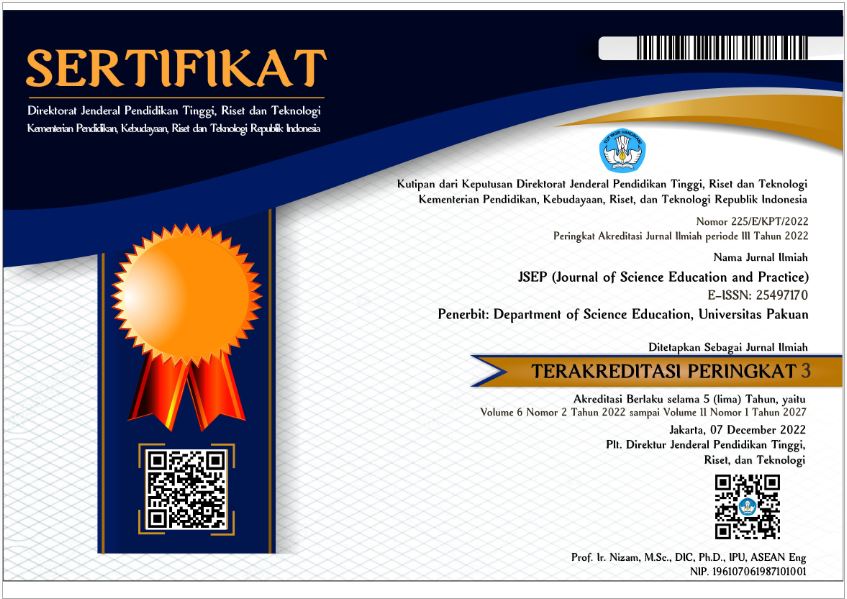ADDITIONAL MENU
Project-Based Learning on Biotechnology Materials to Enhance High School Students' Creativity and Problem-Solving Skills
Abstract
This study aims to improve students' problem-solving abilities and creativity through project-based biotechnology learning. The research was conducted at a public high school in Gunung Putri, Bogor. This study involved students of class XI science which were divided into 2 groups, namely the experimental class and the control class. The research method used quasi-experimental with non-equivalent pretest-posttest control group design. The instruments used essays, questionnaires and observations. The results of this study are supported by the n-gain value of problem solving ability and creative thinking in the experimental class 0.73 (high) and the control class 0.53 (medium). Learning activities are very active and dynamic, students must communicate, be creative, think critically and collaborate. Student response was very enthusiastic. The conclusion of the research can be seen that project-based learning can improve problem solving and creativity of high school students.
Keywords
References
Ozen, Y. (2016). Can I Solve the Problem?A Program Trail on Problem Solving Skill. American Journal of Applied Psychology, 4(1), 110. https://doi.org/10.12691/ajap-4-1-1
Badia, J. D. (2017). Creative Project-based learning to boost technology innovation.
Brundiers, K., Wiek, A., & Redman, C. L. (2010). Real-world learning opportunities in sustainability: from classroom into the real world. International Journal of Sustainability in Higher Education, 11(4), 308324. https://doi.org/10.1108/14676371011077540
Caballero, M. D., & Knight, J. K. (2013). How Can We Improve Problem Solving in Undergraduate Biology ? Applying Lessons from 30 Years of Physics Education Research. 12, 153161. https://doi.org/10.1187/cbe.12-09-0149
Chiang, C. L., & Lee, H. (2016). The Effect of Project-Based Learning on Learning Motivation and Problem-Solving Ability of Vocational High School Students. 6(9). https://doi.org/10.7763/IJIET.2016.V6.779
Chin, C., & Chia, L. G. (2004). Implementing project work in biology through problem-based learning. Journal of Biological Education, 38(2), 6975. https://doi.org/10.1080/00219266.2004.9655904
Halil TURGUT. (2008). Prospective Science Teachers Conceptualizations About Project Based. International Journal of Instruction, 1(1), 6279.
Hanney, R., & Savin-Baden, M. (2013). The problem of projects: understanding the theoretical underpinnings of project-led PBL. London Review of Education, 11(1), 719. https://doi.org/10.1080/14748460.2012.761816
Kapp, E. (2009). Improving Student Teamwork in a Collaborative Project-Based Course. College Teaching, 57(3), 139143. https://doi.org/10.3200/CTCH.57.3.139-143
Kim, K. H. (2011). The Creativity Crisis: The Decrease in Creative Thinking Scores on the Torrance Tests of Creative Thinking. Creativity Research Journal, 23(4), 285295. https://doi.org/10.1080/10400419.2011.627805
Kizkapan, O., & Bektas, O. (2017). The effect of project based learning on seventh grade students academic achievement. International Journal of Instruction, 10(1), 3754. https://doi.org/10.12973/iji.2017.1013a
Krumm, G., Arán Filipppetti, V., Lemos, V., Koval, J., & Balabanian, C. (2016). Construct validity and factorial invariance across sex of the Torrance Test of Creative Thinking Figural Form A in Spanish-speaking children. Thinking Skills and Creativity, 22, 180189. https://doi.org/10.1016/j.tsc.2016.10.003
Malang, U. N., Malang, U. N., & Malang, U. N. (2017). Improving Creative Thinking Skills of Students through Differentiated Science Inquiry Integrated with Mind Map. 14(4), 7791. https://doi.org/10.12973/tused.10214a
Meyer, K., & Wurdinger, S. (2016). Students Perceptions of Life Skill Development in Project-Based Learning Schools. In Journal of Educational Issues (Vol. 2, Issue 1, p. 91). https://doi.org/10.5296/jei.v2i1.8933
Natadiwijaya, I. F. Rahmat, A. Redjeki, S & Anggraeni, S. (2018).How To Practice Creative Thinking Skill through Scaffolding on Biotechnology Content. Journal of Physics Conferenseries.1013.
Nurlaely, N., Permanasari, A., & Riandi, R. (2017). Students STEM Literacy in Biotechnology Learning at Junior High School. Journal of Physics: Conference Series, 895(1). https://doi.org/10.1088/1742-6596/895/1/012155
Phumeechanya, N., & Wannapiroon, P. (2013). Ubiquitous Scaffold Learning Environment Using Problem-based Learning to Enhance Problem-solving Skills and Context Awareness. International Journal on Integrating Technology in Education, 2(4), 2333. https://doi.org/10.5121/ijite.2013.2403
Pursitasari, I. D., & Permanasari, A. (2012). Model Integrated Problem Solving Based Learning Pada Perkuliahan Dasar-Dasar Kimia Analitik. Jurnal Ilmu Pendidikan, 18(2), 172178. http://download.portalgaruda.org/article.php?article=98905&val=398&title=Model Integrated Problem Solving Based Learning pada Perkuliahan Dasar-dasar Kimia Analitik.
Salam, F., Mailok, R., Ubaidullah, N., & Ahmad, U. (2016). the Effect of Project-Based Learning Against Students Engagement. International Journal of Development Research, 6(02), 68916895.
Sari, D. K., Permanasari, A., & Supriyanti, F. M. T. (2017). Profile of Student Creative Thinking Skills on Quantitative Project Based Protein Testing Using Local Materials. Jurnal Pendidikan IPA Indonesia. 6(1), 7175. https://doi.org/10.15294/jpii.v6i1.9516
Sugiyono. (2009). Metode Penelitian Pendidikan (Pendekatan Kuantitatif, Kualitatif, dan R&D) Bandung: Alfabeta.
Suprijono, A. (2013). Cooperative Learning (Teori & Aplikasi PAIKEM). Yogyakarta: Pustaka Pelajar.
Tamim, S. R., & Grant, M. M. (2013). Definitions and Uses: Case Study of Teachers Implementing Project-based Learning. Interdisciplinary Journal of Problem-Based Learning, 7(2), 516. https://doi.org/10.7771/1541-5015.1323
Wekesa, N. W., & Ongunya, R. O. (2016). Project Based Learning on Students Performance in the Concept of Classification of Organisms among Secondary Schools in Kenya. Journal of Education and Practice, 7(16), 2531.
Wismath, S. L., & Orr, D. (2015). Collaborative Learning in Problem Solving : A Case Study in Metacognitive Learning Collaborative Learning in Problem Solving : A Case Study in. 6(3).
DOI: 10.33751/jsep.v6i1.5704
 Abstract views : 938
Abstract views : 938
Refbacks
- There are currently no refbacks.
Copyright (c) 2022 JSEP (Journal of Science Education and Practice)

This work is licensed under a Creative Commons Attribution 4.0 International License.












